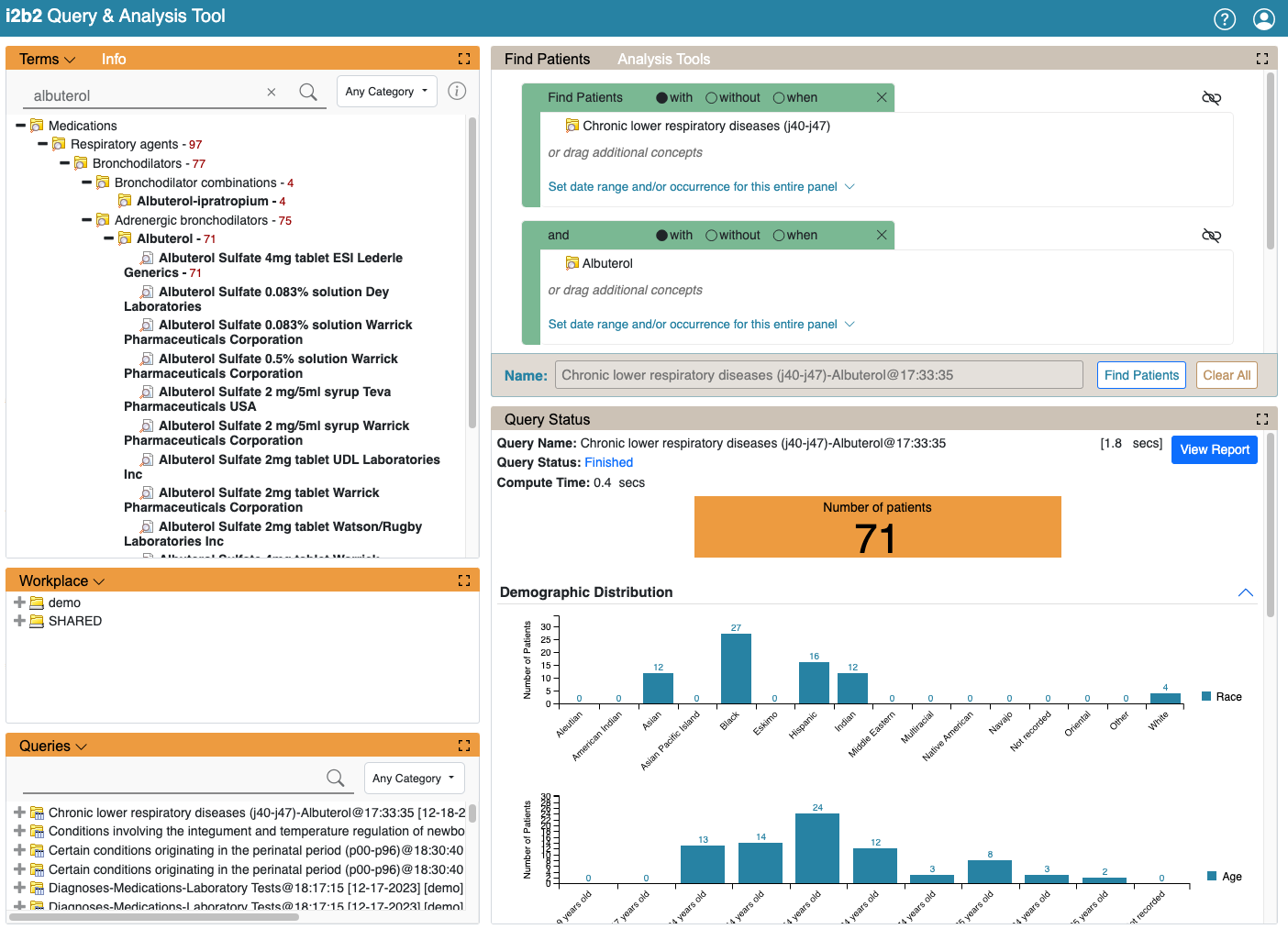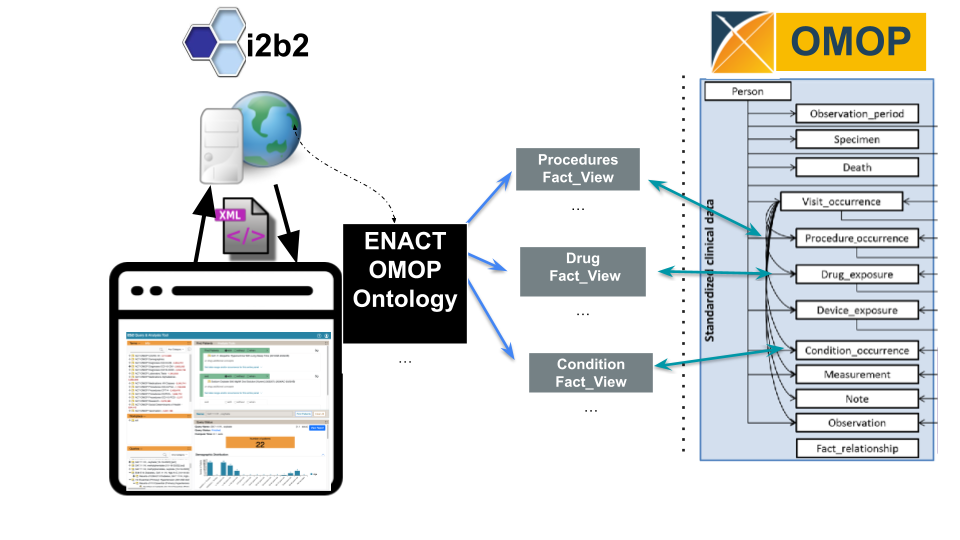Page History
| Table of Contents | ||
|---|---|---|
|
| Info Box | ||
|---|---|---|
| ||
Downloads:
Documentation:
|
1.8.0 Release Notes
i2b2 1.8 Release includes the newly redesigned i2b2 Web interface, ACT i2b2 on OMOP functionality, few improvements and bug fixes..0 Release introduces two major improvements to the platform that enhance usability and applicability: a redesigned and completely rewritten i2b2 Web Interface to improve the user experience, and core support for the OMOP data model on MSSQL and Oracle databases. These changes represent a major step forward in i2b2.
Highlight of Features
Top New Features
Contribution
Contributor
Description
New Web client User Interface
Nick Benik (Harvard Medical School)
| Description | ||
|---|---|---|
New Web client User Interface |
ACT i2b2 on OMOP for MSSQL and Oracle databases
Bug fixes
Community-Contributed Features
The completely rewritten web client represents a major step forward for i2b2 that features an improved layout, greater visual customization, and a new plugin architecture. The new web client version eliminates usage of YUI |
and uses the latest versions of jQuery, Bootstrap 5 and Golden-Layout libraries, which will ensure maintainability far into the future. |
i2b2 on OMOP |
for MSSQL and Oracle databases | The core i2b2 platform now supports the OMOP data model, which is queryable through the comprehensive ENACT-OMOP Ontology. (MSSQL and Oracle are supported. Postgres support will be added in 1.8.1.) | |
Bug fixes | Bug fixes are included that are needed for OMOP support and for long-running breakdowns. |
Community-Contributed Features
Contribution | Contributor | Description |
ACT-OMOP design and ontology | Michele Morris (University of Pittsburgh) Mike Mendis, Jeff Klann, Reeta Metta (Mass General Brigham) | With i2b2 interface, using ACT The ENACT-OMOP Ontology , queries can be run against OMOP data with OMOP table view structure. For information on installing and running queries using ACT-OMOP Data modelpowers the i2b2 queries against OMOP data, and the design of the database views enables the queries to run. |
1.8.1 will be released In April 2024 and will add Postgres support for OMOP, Snowflake database support, SQL job scheduling, and improved data export.
Detailed Documentation on New Features
New Web client User Interface
The new Web Client modernizes the i2b2 query tool, and features:
- Removal of antiquated support libraries.
- Creation of new compartmentalized plugin execution environment with support for legacy plugins.
- Drag and Drop system reworked to use browser-native operations.
See i2b2 Web Client Install for installation instructions.
The Admin functionality is still supported through the classic web client. See i2b2 Administration Module Install for more information. In particular, pay attention to the configuration file change in 6.4 Configuration which enables an admin-only version of the classic webclient.
ACT i2b2 on OMOP
...
for MSSQL and Oracle databases
...
ACT i2b2 on OMOP functionality uses ACT Ontology in the front-end and enables the i2b2 Software to run against a database that uses the OMOP CDM architecture.
The following steps will load Documentation on loading the OMOP metadata and , CRC tables, and the CRC OMOP Views required to query the OMOP tables .
| Info |
|---|
The CPT4 ontology table is not included with i2b2 due to AMA restrictions on redistribution of CPT code information. Contact the ACT team to get a copy if your institution is an AMA member. |
Step 1: Load Ontology tables
- Download and extract the new install zip package from "Download Binary Distribution" section of https://www.i2b2.org/software
- Edit the edu.harvard.i2b2.data\Release_1-7\NewInstall\Metadata\db.properties file to update the project properties to 'ACT-OMOP'; example: db.project=ACT-OMOP
- From the edu.harvard.i2b2.data\Release_1-7\NewInstall\Metadata folder, run the ant command: ant -f data_build.xml db_metadata_load_data
- This will execute the SQL scripts from the edu.harvard.i2b2.data\Release_1-7\NewInstall\Metadata\act\scripts\<db type> folder and will create and load ACT-OMOP Ontology metadata tables.
- You can now verify the new Ontology by logging into the web client.
Step 2: Load OMOP views and Concept dimension
- From the edu.harvard.i2b2.data\Release_1-7\NewInstall\Crcdata folder, run the ant command: ant -f data_build.xml db_demodata_load_data
- This will execute the BUILD_ACT_OMOP_Views _<dbtpye> script from the edu.harvard.i2b2.data\Release_1-7\NewInstall\crcdata\act-omop\scripts\<db type> folder and will create the OMOP views under the Views section in the database.
- In addition, the corresponding ACT-OMOP concept_dimension data is populated by executing the scripts form the crcdata.zip folders.
2. You can now run queries against the OMOP tables from the web client interface
| Note |
|---|
Delete your Patient_dimension and Visit_dimension tables before executing the crc scripts. The OMOP views will build these as Views. |
Step 3: Execute Totalnum counts
Load and execute file totalnum_usp/sqlserver/totalnum_fast_prep_OMOP.sql and run the following command:
exec totalnum_fast_prep_OMOP 'observation_fact','dbo','@
When finished, verify by checking that c_totalnum columns in your ontology tables contain numbers. These total counts will be visible in the ontology browser in the web client for 2b2 users with DATA_AGG user permission.
| Info |
|---|
Ontologies derived from visit_dimension or patient_dimension top folders will not have counts because of the way these terms are defined and cannot be rolled up. |
can be found here: i2b2-on-OMOP With ENACT-OMOP Ontology v4.1
For historical reference on old 2018 OMOP installation , refer to OMOP Home on i2b2 Community Wiki
| Info |
|---|
For enabling use of an OMOP database with i2b2, follow the instructions in the install guide for a new install of i2b2 using the i2b2-OMOP install option. The documentation here will guide you through this process. i2b2-on-OMOP With ENACT-OMOP Ontology v4.1 |
ACT OMOP Totalnum Scripts
Totalnum Scripts (patient counting scripts) have been updated to improve the counter's performance on both multiple ontology tables and very large(>1.5 million) ontologies such as ACT medications. Debug messages have also been added for troubleshooting and profiling purposes. Support for multiple fact tables has been added and bugfixes have been made.
Totalnum Scripts Setup
- If upgrading, create the totalnum and totalnum_report tables. In Release_1-7/Upgrade/Metadata, run the ant upgrade script.
ant -f data_build.xml upgrade_tables_release_1-7-12a - In the Release_1-7/NewInstall/Metadata/ run the ant script to create the stored procedures.
ant -f data_build.xml create_metadata_procedures_release_1-7 - Set privileges: If using multiple schemas, the stored procedure should be run from the metadata schema. Make sure the stored procedure can read the tables in the crcdata schema (observation_fact, visit_dimension, patient_dimension) and can both read an update ontology tables in the metadata schema (including table_access).
- If using multiple fact tables, the recommended approach is to create a fact table view as the union of all your fact tables. (This is essentially going back to a single fact table, but it is only used for totalnum counting. This is needed to correctly count patients that mention multiple fact tables within a hierarchy.)
e.g., create view observation_fact_view as select * from CONDITION_VIEW union all select * from drug_view
If running the counting script in SQL Server, add the wildcard flag, to ignore multifact references in the ontology: e.g. exec RunTotalnum 'observation_fact_view','dbo','@','Y'
This is automatically accounted for in the other database platforms. Note this approach does not work if you have conflicting concept_cds across fact tables. - Run the stored procedures on your database. This can be done in two ways:
- Run the ant command to execute the data_build.xml file with below specified target
POSTGRESQL : ant -f data_build.xml db_metadata_run_total_count_postgresql
ORACLE : ant -f data_build.xml db_metadata_run_total_count_oracle
SQL SERVER : ant -f data_build.xml db_metadata_run_total_count_sqlserver - Execute the RunTotalNum stored procedure manually against your database from a SQL Client. This can take several hours for large databases or large ontologies. Examples are below.
- Run the ant command to execute the data_build.xml file with below specified target
Oracle:
...
begin
RUNTOTALNUM('observation_fact','i2b2demodata');
end;
You can optionally include a table name if you only want to count one ontology table (this IS case sensitive):
begin
runtotalnum('observation_fact','i2b2demodata','I2B2');
end;
Note: If you get the error as: ERROR at line 1: ORA-01031: insufficient privilege, then run the command:
grant create table to (DB USER)
...
When finished, verify it is complete by checking that c_totalnum columns in your ontology tables contain numbers (not nulls). These total counts will be visible in the ontology browser in the web client.
Parent folders will get counts (of all patients with facts in the leaves) except for ontology folders derived from visit_dimension or patient_dimension. These cannot be rolled up because of the way these terms are defined in the ontology. They will have no count at all (not a zero).
| Info |
|---|
i2b2 users must have the DATA_AGG user permission to view the counts through the web client. |
Improved CRC scripts execution Process
Prior to 1.8 release, CRC scripts via ANT execution command supported single CRC zip folder structure. 1.8 release will support multiple CRV zip folder execution. The databuild.xml has been modified for this process.
with bugfixes, and the MSSQL version has been rewritten and is 5x faster.
Patient Counting Scripts ("totalnum")
Changelog
Database Drivers
The JDBC drivers were updated to the following versions.
Server Type | oracle | Postgresql | mssql |
|---|---|---|---|
Driver Version | ojdbc8.jar | postgresql-42.2.14.jar | mssql-jdbc-9.2.0.jre8.jar |
Driver Version
Oracle 21.5
PostgreSQL 42.3.2
MSSql Server 9.2
Supported Db Server versions
Server Type | SQL Server | Oracle | PostgresSQL |
|---|---|---|---|
Supported Version/s | 2012+ (tested with up to 2019) | 12g+ and 21c | 9 to 14 |
Supported software versions
Application Type | Java | Wildfly | Apache HTD | Apache Ant | Apache Axis2 |
|---|
PHP | ||||||
Supported Version/s | 8 or 11 | 17.0.1Final | 2.0 (RHEL 6) and 2.2 ( RHEL 7) | 1.9.6 | 1.7.1 | 7.2.27 or |
|---|
| higher |
Supported Operating Systems
Rocky linux 8 and 9, CentOS versions 7
Windows 2016 -2019
- There is a new PHP install process for IIS in the i2b2 install guide: 2.5.3.2 PHP for Windows
Unofficially, MacOS and other flavors of Linux are likely to work.
i2b2 Server and Client Changes
New Features and Improvements
| Web client |
|---|
WEBCLIENT-360 New web client User Interface |
classic webclient - configurable for Admin functionality |
| Core-server |
|---|
CORE-426 running i2b2 on OMOP data model CORE-433 i2b2 on Rocky Linux 9 (CentOS 7 hits EOL 6/2024) |
i2b2 Database Changes
New Features and Improvements
Bug Fixes
| Core-server / Data |
|---|
CORE-440 Queries from queue are not processing and returning back CORE-441 DB Locking issue- can't show previous query when a query is |
running CORE-442 Get_children doesn't work on Modifier folders CORE-444 Breakdowns for non-Patient_dimension views - don't work CORE-443 Breakdown queueing CORE-445 java code folder structure for 1.7 should be changed to refer to 1.8 CORE-446 php install process on IIS has changed; documentation needs to be update |
| DATA-36 Wrong driver version jdbc 10.2 vs 9.2 in default datasource for MSSQL |
Notes for Developers
For Java 11 install, if you change the xsd (REST API message definitions), then you will need to regenerate gensrc via JAXB in Java 8. In the i2b2-core cell directory for which you're regenerating the XSD-Java, run the ant target "jaxb_gen" on Java 8 and then build as usual using Java 11.
...
.svg.med.png)

